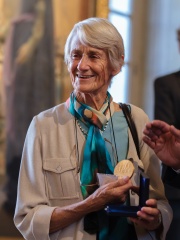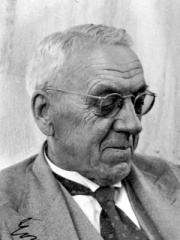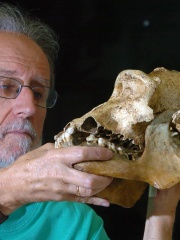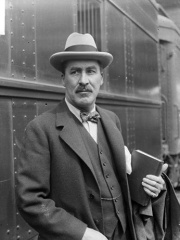
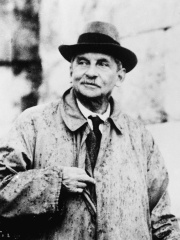
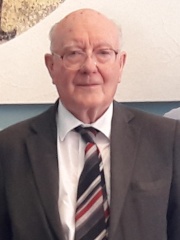
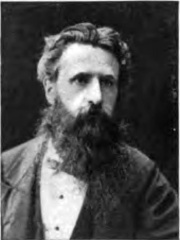
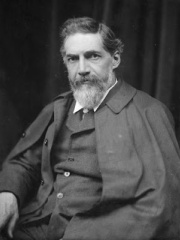
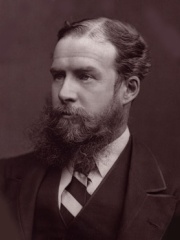
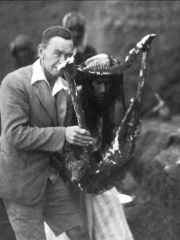
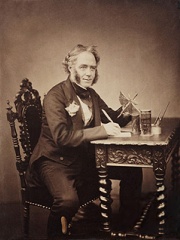
The Most Famous
ARCHAEOLOGISTS from United Kingdom
This page contains a list of the greatest British Archaeologists. The pantheon dataset contains 151 Archaeologists, 34 of which were born in United Kingdom. This makes United Kingdom the birth place of the most number of Archaeologists.
Top 10
The following people are considered by Pantheon to be the top 10 most legendary British Archaeologists of all time. This list of famous British Archaeologists is sorted by HPI (Historical Popularity Index), a metric that aggregates information on a biography's online popularity. Visit the rankings page to view the entire list of British Archaeologists.

1. Howard Carter (1874 - 1939)
With an HPI of 77.35, Howard Carter is the most famous British Archaeologist. His biography has been translated into 79 different languages on wikipedia.
Howard Carter (9 May 1874 – 2 March 1939) was a British archaeologist and Egyptologist who became known for discovering the intact tomb of the 18th Dynasty Pharaoh Tutankhamun in November 1922, the best-preserved pharaonic tomb ever found in the Valley of the Kings.

2. Arthur Evans (1851 - 1941)
With an HPI of 74.09, Arthur Evans is the 2nd most famous British Archaeologist. His biography has been translated into 55 different languages.
Sir Arthur John Evans (8 July 1851 – 11 July 1941) was a British archaeologist and pioneer in the study of Aegean civilization in the Bronze Age. The first excavations at the Minoan palace of Knossos on the Greek island of Crete began in 1877. They were led by Cretan Greek Minos Kalokairinos, a native of Heraklion. Three weeks later Ottoman authorities forced him to stop (at the time, Crete was under Ottoman rule). Almost three decades later, Evans heard of Kalokairinos' discovery. With private funding, he bought the surrounding rural area including the palace land. Evans began his own excavations in 1900. Based on the structures and artefacts found there and throughout the eastern Mediterranean, Evans found that he needed to distinguish the Minoan civilisation from Mycenaean Greece. Evans was also the first to define the Cretan scripts Linear A and Linear B, as well as an earlier pictographic writing.

3. Colin Renfrew (1937 - 2024)
With an HPI of 70.91, Colin Renfrew is the 3rd most famous British Archaeologist. His biography has been translated into 34 different languages.
Andrew Colin Renfrew, Baron Renfrew of Kaimsthorn, (25 July 1937 – 24 November 2024) was a British archaeologist, paleolinguist and Conservative peer noted for his work on radiocarbon dating, the prehistory of languages, archaeogenetics, neuroarchaeology, and the prevention of looting at archaeological sites. Renfrew was also the Disney Professor of Archaeology at the University of Cambridge and Director of the McDonald Institute for Archaeological Research, and was a Senior Fellow of the McDonald Institute for Archaeological Research.

4. George Smith (1840 - 1876)
With an HPI of 68.23, George Smith is the 4th most famous British Archaeologist. His biography has been translated into 26 different languages.
George Smith (26 March 1840 – 19 August 1876) was a pioneering English Assyriologist who first discovered and translated the Epic of Gilgamesh, one of the oldest-known written works of literature.
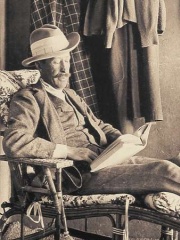
5. George Herbert, 5th Earl of Carnarvon (1866 - 1923)
With an HPI of 67.03, George Herbert, 5th Earl of Carnarvon is the 5th most famous British Archaeologist. His biography has been translated into 38 different languages.
George Edward Stanhope Molyneux Herbert, 5th Earl of Carnarvon, (26 June 1866 – 5 April 1923), styled Lord Porchester until 1890, was an English peer and aristocrat best known as the financial backer of the search for and excavation of Tutankhamun's tomb in the Valley of the Kings.

6. Flinders Petrie (1853 - 1942)
With an HPI of 65.10, Flinders Petrie is the 6th most famous British Archaeologist. His biography has been translated into 40 different languages.
Sir William Matthew Flinders Petrie ((1853-06-03)3 June 1853 – (1942-07-29)29 July 1942), commonly known as simply Sir Flinders Petrie, was an English Egyptologist and a pioneer of systematic methodology in archaeology and the preservation of artefacts. He held the first chair of Egyptology in the United Kingdom, and excavated many of the most important archaeological sites in Egypt in conjunction with his Irish-born wife, Hilda Urlin. Some consider his most famous discovery to be that of the Merneptah Stele, an opinion with which Petrie himself concurred. Undoubtedly at least as important is his 1905 discovery and correct identification of the character of the Proto-Sinaitic script, the ancestor of almost all alphabetic scripts. Petrie developed the system of dating layers based on pottery and ceramic findings. Petrie has been denounced for his pro-eugenics views; he was a dedicated believer in the superiority of the Northern peoples over the Latinate and Southern peoples. He has been referred to as the "father of Egyptian archaeology".

7. John Lubbock, 1st Baron Avebury (1834 - 1913)
With an HPI of 64.24, John Lubbock, 1st Baron Avebury is the 7th most famous British Archaeologist. His biography has been translated into 28 different languages.
John Lubbock, 1st Baron Avebury (30 April 1834 – 28 May 1913), known as Sir John Lubbock, 4th Baronet, from 1865 until 1900, was an English banker, Liberal politician, philanthropist, scientist and polymath. Lubbock worked in his family company as a banker but made significant contributions in archaeology, ethnography, and several branches of biology. He coined the terms "Palaeolithic" and "Neolithic" to denote the Old and New Stone Ages, respectively. He helped establish archaeology as a scientific discipline, and was influential in debates concerning evolutionary theory. He introduced the first law for the protection of the UK's archaeological and architectural heritage. He promoted the establishment of public libraries and was also a founding member of the X Club.

8. Leonard Woolley (1880 - 1960)
With an HPI of 62.56, Leonard Woolley is the 8th most famous British Archaeologist. His biography has been translated into 29 different languages.
Sir Charles Leonard Woolley (17 April 1880 – 20 February 1960) was a British archaeologist best known for his excavations at Ur in Mesopotamia. He is recognized as one of the first "modern" archaeologists who excavated in a methodical way, keeping careful records, and using them to reconstruct ancient life and history. Woolley was knighted in 1935 for his contributions to the discipline of archaeology. He was married to the British archaeologist Katharine Woolley.

9. John O. Westwood (1805 - 1893)
With an HPI of 62.39, John O. Westwood is the 9th most famous British Archaeologist. His biography has been translated into 19 different languages.
John Obadiah Westwood (22 December 1805 – 2 January 1893) was an English entomologist and archaeologist noted for his artistic talents. He published several illustrated works on insects and antiquities. He was among the first entomologists with an academic position at Oxford University. He was a natural theologian, staunchly anti-Darwinian, and sometimes adopted a quinarian viewpoint. Although he never travelled widely, he described species from around the world on the basis of specimens, especially of the larger, curious, and colourful species obtained by naturalists and collectors in England.
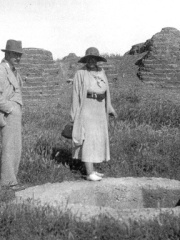
10. Max Mallowan (1904 - 1978)
With an HPI of 61.49, Max Mallowan is the 10th most famous British Archaeologist. His biography has been translated into 24 different languages.
Sir Max Edgar Lucien Mallowan, (6 May 1904 – 19 August 1978) was a prominent British archaeologist and academic, specializing in the Ancient Near East. Having studied classics at Oxford University, he was trained for archaeology by Leonard Woolley at Ur and Reginald Campbell Thompson at Nineveh. He then directed a number of archaeological expeditions sponsored by the British Museum and the British School of Archaeology in Iraq. He was the second husband of Agatha Christie, having met her during the excavation at Ur in 1930. He served in the Royal Air Force Volunteer Reserve during the Second World War, and then entered academia. He was Professor of Western Asiatic Archaeology at the University of London (1947–1962) and a fellow of All Souls College, Oxford (1962–1971).
People
Pantheon has 34 people classified as British archaeologists born between 1799 and 1942. Of these 34, 1 (2.94%) of them are still alive today. The most famous living British archaeologists include Meave Leakey. The most famous deceased British archaeologists include Howard Carter, Arthur Evans, and Colin Renfrew.
Living British Archaeologists
Go to all RankingsDeceased British Archaeologists
Go to all RankingsHoward Carter
1874 - 1939
HPI: 77.35
Arthur Evans
1851 - 1941
HPI: 74.09
Colin Renfrew
1937 - 2024
HPI: 70.91
George Smith
1840 - 1876
HPI: 68.23
George Herbert, 5th Earl of Carnarvon
1866 - 1923
HPI: 67.03
Flinders Petrie
1853 - 1942
HPI: 65.10
John Lubbock, 1st Baron Avebury
1834 - 1913
HPI: 64.24
Leonard Woolley
1880 - 1960
HPI: 62.56
John O. Westwood
1805 - 1893
HPI: 62.39
Max Mallowan
1904 - 1978
HPI: 61.49
Robert Broom
1866 - 1951
HPI: 61.15
Colin Groves
1942 - 2017
HPI: 60.23
Overlapping Lives
Which Archaeologists were alive at the same time? This visualization shows the lifespans of the 25 most globally memorable Archaeologists since 1700.

